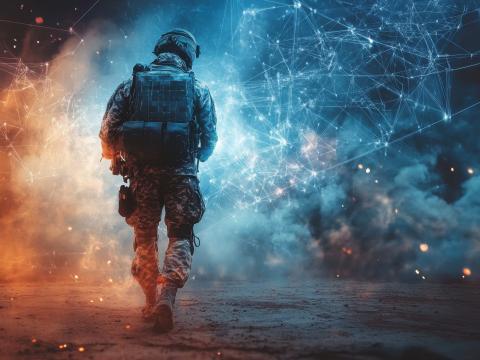Small Data May Have Big Impact on Artificial Intelligence at the Edge
While big data has garnered much attention in recent years, small datasets and artificial intelligence (AI) can provide valuable benefits on the battlefield, according to Margaret Loper, associate director of operations for the Georgia Tech Research Institute’s Information and Communications Laboratory (ICL).
“There was a period of time where everything was about big data, big data, big data. We need lots of data. You have to have big data to learn over, to predict from. But the reality is, with this kind of proliferation of intelligence and computation at the edges, what we really have is a lot of small data, and small data can be very informative, Loper, who has also been serving as the ICL’s acting director, told SIGNAL Media.
ICL researchers conducted a 2021 study on the value of small data at the edge. The study explains that small data is “hyper contextualized semantically rich data and requires operational practices to unlock.” The volume or format of small data makes it “accessible, understandable, and actionable by humans” and is “primarily used to find causality and can facilitate human-machine collaboration in AI training,” the study stated, adding that by 2040, “small data will play a key transformational role in developing AI models with more predictive power in targeted contexts.”
The study found that at the tactical edge, intelligent devices will be able to deliver insights without transferring massive amounts of data back to a centralized hub, making systems more efficient since they only need to transmit important information. Additionally, while sensors and meshed signals proliferate at the edge, many systems still struggle with latency and lack of inference power. Drones, for example, collect and stream video but require human operators to interpret and add context. In 2040, sensors, such as wearable sensors for detecting chemical and biological agents, will be capable of synthesizing collected data into a more complete picture that augments real-time intelligence. Hardware advances and low-latency, high-throughput networks underpin speed to insight, the study concluded.
Loper said the study explored the value of small data offering insights into what’s going on in a warfighter’s immediate vicinity at a particular moment rather than “having that concept of all the data flowing back to a higher echelon of decision-making” and trying to make decisions from a holistic view based on the big data.
She used a nonmilitary anecdote to illustrate small data’s value. Without naming names, she told the story of someone she knew who lived in a different state than one of their parents. The person depended on phone conversations to learn how the parent was doing, but unfortunately, only after the parent passed did the person learn bits and pieces of information that might have been helpful.
“When this person went and started to investigate, what they realized is that had they had access to small data about their parent’s everyday life—the fact that he was not walking in the park as frequently, that he hadn’t stopped by the corner grocery store and get a drink as often, that he was not logging on to check his emails frequently. There’s all these little data things that could have actually helped them understand a lot more about what was going on with their parent,” Loper offered. “That’s illustrative of the idea that with the smallest data and pushing decision-making at the edge, there’s a lot that we can understand about our houses, our cities or the battlefield. There’s a lot that we can understand about the small data and patterns that we can collect and understand, versus this idea that we have to have massive data in one place to be able to make a decision and do something.”

There was a period of time where everything was about big data, big data, big data. We need lots of data. But the reality is, with this kind of proliferation of intelligence and computation at the edges, what we really have is a lot of small data, and small data can be very informative.
The ICL and the other labs at GTRI conduct a lot of research for the Department of Defense (DoD), which released a strategy last year for the adoption of data, analytics and AI. Department leaders are focused on transforming into a data-centric force using AI to sort through and analyze available data so that warfighters can make faster, more informed decisions than potential enemies can.
“As a result of implementing this strategy, DoD leaders and warfighters will be able to make rapid, well-informed decisions by expertly leveraging high-quality data, advanced analytics, and AI as part of a continuous, outcome-driven, and user-focused development, deployment, and feedback cycle,” the strategy states.
ICL researchers are not alone in realizing the value of small data. Loper pointed to a brief Bloomberg article about an AI startup, Sakana AI. She had happened to read the article the morning of her SIGNAL Media interview. While many of its competitors build ever-larger AI systems, Sakana, founded by two prominent former Google employees, is working on smaller models that can operate with less data. Sakana means “fish” in Japanese, and its technology draws inspiration from the behavior of schools of fish and flocking birds to get smaller models to function together more efficiently than a large model could,” the article reported.
A 2020 article in “Military Review,” an Army professional journal, also described potential tactical edge benefits from small data. “It is unlikely that tactical leaders will have a deep understanding of big data from their military education and training. Developing such knowledge requires specialized skills and years of education,” Col. Harry D. Tunnell IV, USA (Ret.), wrote in the article. He went on to say, “Having a battle staff that can perform exploratory analysis with small datasets is important. It lowers the burden on what will be a small tactical data science team, and it lessens the need to request intelligence products from another headquarters.”
A renewed recognition of small data’s power is only one technology trend Loper has witnessed during a nearly 30-year career at the ICL. It is closely related to a fluctuation between centralized and decentralized computing. “Things were very centralized when I got my first job out of college. Processing was very centralized and over time became more distributed as personal computers and powerful workstations were available to do processing,” she recalled. “And with the advent of cloud, then of course, there became a more centralized notion again of keeping all the data in the cloud, so that you had access to it to be able to do whatever type of analytics and computation prediction. And I think that now what you see is this interesting desire to go back to information at the edge.”
Centralized cloud computing is, in some respects, easier to protect and manage, she added. “But with this new push to information edge, the smart cities concept is going to have sensors everywhere, and you’re going to have intelligence in houses and streets and cars, where you see a push of the importance of distributed computing again, and nuance of pushing decision-making to the edge. There’s this fluctuating between centralized and distributed.”
Another major trend she has noted affects the military and others: the need for humans to trust AI systems. “Humans and AI will be working together in different contexts, so what does that look like? What does it mean for a human and AI to team together, or for humans to believe AI?”
The ICL focuses on information science, which investigates the properties and behavior of information, the forces governing the flow of information and the means of processing information for optimum accessibility and usability. The research covers a broad spectrum—no pun intended—that includes next-generation cellular capabilities known as 5G and FutureG, along with data modeling, analytics and informatics, AI, electronic warfare and systems interoperability.
Specific projects include 5G-related efforts for “smart” military bases. The ICL has built a 5G/FutureG laboratory with separate “new radio” networks, including over-the-air capabilities, commercial handsets and Internet of Things devices. The available networks include: a frequency-agile, scalable network widely used by top-tier chipset manufacturers for terminal testing, a fully virtualized network for optimizing network configurations and parameters against repeatable conditions and impairments, and an open-source system for deeper system analysis.
The lab also developed the Army Families Web Portal, an enterprise data system that provides information to support service members and their families, as well as Georgia’s Medicaid Enterprise System Transformation, a major, multiyear, overhaul of the state’s Medicaid enterprise system.
In addition to the military, the lab conducts research for other government departments and agencies, including the Justice Department, the Centers for Disease Control and Prevention and the state of Georgia. ICL personnel also are working on Georgia’s All-Payer Claims Database, which allows users to compare prices for medical procedures.
The lab currently has 71 externally funded projects and 15 projects funded through internal research and development. Loper estimates that about 20% of the lab’s work is classified.






Comments